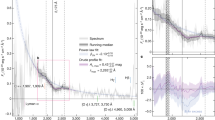Abstract
Overbeck1 first predicted that the images of cosmic X-ray sources might have observable haloes due to coherent forward scattering by interstellar dust grains, and it was recognized that the observations of these haloes would provide a powerful tool for analysing the size distribution and composition of the grains2–5. Observations with the Einstein observatory have provided evidence of faint haloes extending to a few arc minutes beyond the X-ray images of supernova remnants6,7 and several compact galactic sources8–11. The evidence that the haloes are actually due to interstellar grain scattering appears substantial, but it is subject to some uncertainty resulting from the dependence of the point response function (PRF) of the telescope on the source spectra (the observed haloes are brighter than the predicted PRF by factors of approximately 1.5–2). In this letter we show how observations of the time-dependence of the halo X-ray emission may be analysed to determine the location, size distribution, and composition of interstellar grains. Indeed, it should be possible to observe and analyse the halo emission during eclipse even without imaging the source, and we suggest that such haloes probably account for the soft X-rays that have been observed during eclipses or dips in several binary systems.
This is a preview of subscription content, access via your institution
Access options
Subscribe to this journal
Receive 51 print issues and online access
$199.00 per year
only $3.90 per issue
Buy this article
- Purchase on Springer Link
- Instant access to full article PDF
Prices may be subject to local taxes which are calculated during checkout
Similar content being viewed by others
References
Overbeck, J. W. Astrophys. J. 141, 864–866 (1965).
Slysh, V. I. Nature 224, 159–161 (1969).
Hayakawa, S. Prog. theor. Phys. 43, 1224–1230 (1970).
Martin, P. G. & Sciama, D. W. Astrophys. Lett. 5, 193–196 (1970).
Martin, P. G., Mon. Not. R. Astr. Soc. 149, 221–235 (1970).
Stewart, G. C., Fabian, A. C. & Seward, F. D. in Supernova Remnants and their X-Ray Emission (eds Danziger, J. & Gorenstein, P.) 59–64 (Reidel, Dordrecht, 1983).
Mauche, C. W. & Gorenstein, P. in Proc. Workshop on the Crab Nebula and Related Supernova Remnants (eds Kafatos, M. C. & Henry, R. B. C.) 81–88 (Cambridge University Press, 1985).
Rolf, D. P. Nature 302, 46–48 (1983).
Catura, R. C. Astrophys. J. 275, 645–651 (1983).
Mauche, C. W. & Gorenstein, P. Astrophys. J. (in the press).
Bode, M. F., Priedhorsky, W. C., Norwell, G. A. & Evans, A. Astrophys. J. 299, 845–851 (1985).
Mathis, J. S., Rumpl, W. & Nordsieck, K. H. Astrophys. J. 217, 425–433 (1977).
van de Hulst, H. C. Light Scattering by Small Particles (Wiley, New York, 1957).
Trümper, J. & Shönfelder, V. Astron. Astrophys. 25, 445–450 (1973).
Spiegelhauer, H. & Trümper, J. J. Br. Interplanetary Soc. 28, 319–325 (1975).
Draine, B. T. & Lee, H. M. Astrophys. J. 285, 89–108 (1984).
Alcock, C. & Hatchett, S. Astrophys. J. 222, 456–470 (1978).
Morrison, R. & McCammon, D. Astrophys. J. 270, 119–122 1983.
Spitzer, L. Jr Physical Processes in the Interstellar Medium (Wiley: New York, 1978).
Henke, B. L., Lee, P., Tanaka, T. J., Shimabukuro, R. L. & Fujikawa, B. K. Atomic Data and Nuclear Data Tables 27, 1–144 (1982).
Schreier, E., Levinson, R., Gursky, H., Kellogg, E., Tananbaum, H. & Giacconi, R. Astrophys. J. Lett. 172, L79–89 (1972).
White, N. E. in Interacting Binary Stars, Proc. NATO Institute for Advanced Studies (eds Eggleton, P. & Pringle, J.) 249–287 (Reidel, Dordrecht, 1985).
Kitamoto, S. et al. Publ. Astr. Soc. Japan 36, 731–740 (1984).
White, N. E. & Swank, J. H. Astrophys. J. 253, L61–L66 (1982).
White, N. E. et al. Astrophys. J. 283, L9–L12 (1984).
White, N. E. & Holt, S. S. Astrophys. J. 257, 318–337 (1983).
Author information
Authors and Affiliations
Rights and permissions
About this article
Cite this article
Xu, Y., McCray, R. & Kelley, R. Measuring interstellar dust grains from the haloes of binary X-ray sources. Nature 319, 652–653 (1986). https://doi.org/10.1038/319652a0
Received:
Accepted:
Issue Date:
DOI: https://doi.org/10.1038/319652a0
Comments
By submitting a comment you agree to abide by our Terms and Community Guidelines. If you find something abusive or that does not comply with our terms or guidelines please flag it as inappropriate.



